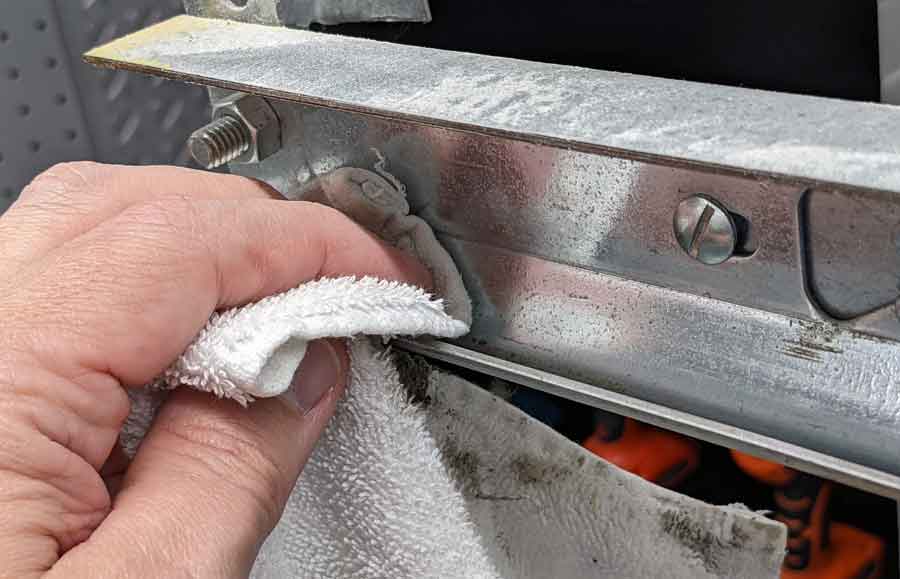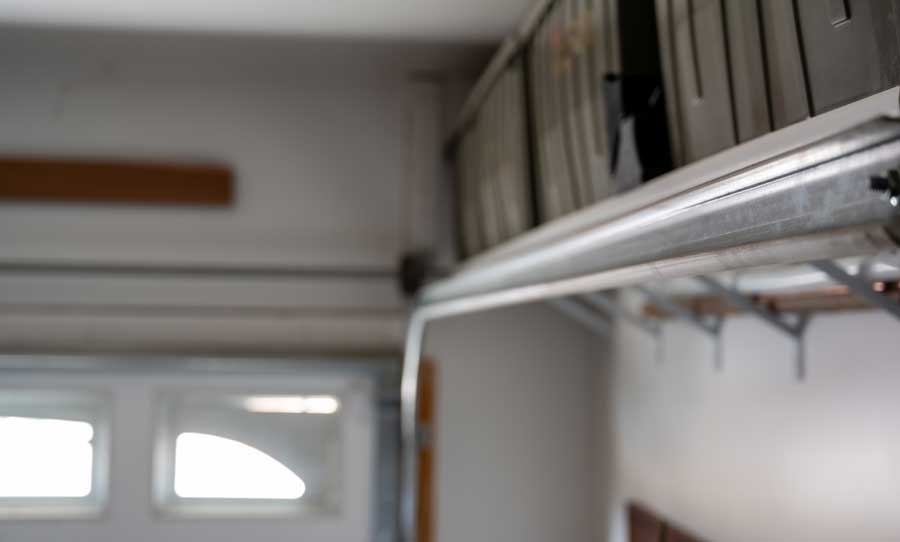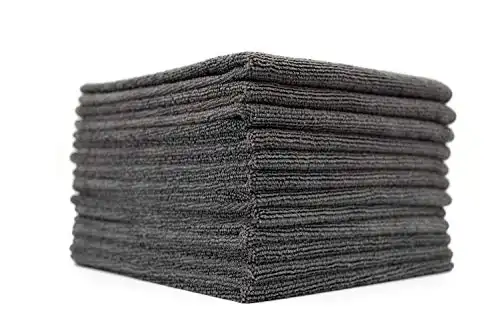If you ask most homeowners how to clean their garage door tracks, they’ll probably tell you to use grease or even WD-40.
That’s precisely what you shouldn’t do.
In this article, we’ll guide you through our simple process of cleaning, maintaining, and troubleshooting your garage door tracks. We’ll also cover how to remove rust and prevent future dirt build-up.
Let’s start with what you should (and shouldn’t) use to clean your garage door tracks.
What Can I Use to Clean Garage Door Tracks?
Over time, your garage door tracks will accumulate dirt, dust, grease, and other debris that can affect your garage door’s performance.
There are a variety of products and tools that can be used effectively to get this job done. Here are some practical options you can use:
Cleaning Solutions
Damp cloth & vacuum cleaner: This is one of the simplest and most economical methods, and it’s excellent at removing dust and loose debris. However, it may not be as effective against stubborn dirt or grease and could leave moisture behind. To start, wipe the tracks with a damp microfiber cloth before using a vacuum cleaner with a hose attachment to remove any leftover debris.
Baking soda and vinegar is a natural, eco-friendly cleaning solution that really does a number on rust and grime. The downside is that it may cause fizzing or bubbling and requires a water rinse afterward. To use this cleaning solution, mix baking soda and vinegar in a spray bottle, spray the tracks, let them sit for a few minutes, then scrub them with a brush or cloth.
Automotive brake cleaner: If you’re dealing with stubborn grease and oil, an automotive brake cleaner will come in handy. This solution is powerful and fast-acting, but it’s also toxic and flammable and may damage rubber or plastic parts. Therefore, wearing gloves and eye protection is crucial when using it. Spray the cleaner on the tracks and wipe it off with a cloth or paper towel.
Detergent or dish soap is a milder cleaning option that’s gentle, safe to use on garage door tracks, and effective for removing dirt and stains. The drawback is that you may need to scrub hard and rinse with water afterward. Mix a mild detergent or dish soap with warm water in a bucket. Dip a cloth or sponge in the solution and scrub the tracks.

Applicators
Soft-bristle brush: Your go-to application tool will be a soft-bristle brush. It’s easy to handle, effective at reaching those hard-to-access spots, and gentle on the tracks. However, it may struggle with tough dirt or grease and might leave some bristles behind. Dip the brush in your chosen cleaning solution and scrub the tracks in a back-and-forth motion.
A toothbrush or small brush is perfect for precision cleaning. They’re excellent at removing rust and grime from small gaps or corners and are gentle on the tracks. However, they might take longer to cover large areas and may require a bit more pressure. To use this method, dip the toothbrush or small brush in your cleaning solution and scrub the tracks in a back-and-forth motion.
Microfiber cloth or sponge: This is perfect for garage door tracks that only need light cleaning. They’re absorbent, great at removing dirt and moisture, and gentle on the metal. They may struggle to remove stubborn dirt or grease, and you might need to rinse them frequently. Soak the cloth or sponge in your chosen cleaning solution and wipe the tracks in a circular motion.
- 12-pack of 12" x 12" towels
- Over 200,000 fibers per square inch to grab dust wherever it's hiding
- PREMIUM 80% Polyester / 20% Polyamide Blend (300gsm)
- Able to withstand hundreds of washings with proper care, getting softer each time
- AMERICA'S PREMIER MICROFIBER Products Manufacturer / Distributor Family-Owned Since 1999.
Drying
Once you’ve cleaned the tracks, it’s essential to dry them properly. Paper towels or a dry cloth can be handy for this task. They’re convenient and practical for absorbing excess moisture and dirt and are available as disposable or reusable options. However, they might not dry the area completely and could leave lint behind. To dry the tracks, pat or wipe them with paper towels or a dry cloth until completely dry.
What You Should Not Use to Clean Garage Door Tracks
While cleaning your garage door tracks is crucial, knowing what not to use is equally important. Some items can damage the tracks, diminish the door’s operation, and potentially void the warranty. Let’s break down some things to avoid and their impact:
Degreasers or Oils: Although they might seem adequate, using them can lead to unnecessary complications. Degreasers can eliminate the lubricant needed for smooth track operations. At the same time, oils can attract dust and grime, resulting in clogged tracks. The aftermath? A noisy, friction-filled door performance, potential misalignment or jamming, and possible damage to the rollers or door.
Abrasive or Highly Alkaline Cleaners: Despite their potent cleaning power, abrasive or highly alkaline cleaners can wreak havoc on your garage door tracks. These cleaners can scratch or dent the tracks and, in the case of highly alkaline cleaners, can cause corrosion or discoloration. The end result is weakened and damaged tracks, reduced visual appeal, and a heightened risk of rust.
Squeegees, Razor Blades, or Other Sharp Instruments: While they might seem handy for removing stubborn dirt, using sharp instruments like squeegees or razor blades can cause long-term damage. These tools can cut or scrape the tracks, which creates gaps or rough edges. The result is uneven or obstructed tracks, which cause increased noise and vibration, diminish door performance and lifespan, and can potentially damage the rollers or door.
Benzene, Gasoline, Acetone, or Carbon Tetrachloride: Toxic, flammable, and volatile substances like benzene, gasoline, acetone, or carbon tetrachloride should be strictly avoided when cleaning garage door tracks. These substances can harm both the tracks and the user. Using them can lead to health hazards, fire risks, environmental harm, and damage to the tracks or other parts of the garage door system.
Pressure Washer: A pressure washer might seem like an efficient cleaning tool, but it can cause substantial damage to garage door tracks. The force of the washer can push water into the tracks, causing rust or corrosion, and can damage the rollers’ rubber seals or plastic parts. The result could be moisture damage, rust damage, reduced performance and lifespan, and potentially a voided warranty.
WD-40 (Red Cap): Although often perceived as a universal solution, the red cap WD-40 isn’t suitable for garage door tracks. It’s not a lubricant but a water displacer and degreaser. Its use can remove the necessary grease, attract dust and grime, and even damage the plastic, nylon, or rubber components of the rollers or the powder coat finish of the door. The consequences are increased noise and friction, reduced performance and lifespan, potential misalignment or jamming, and possibly a voided warranty.
Remember, knowing what to avoid is just as important as knowing what to use when cleaning your garage door tracks. Stick to safe and effective methods for optimal results.
Removing Rust on your Garage Door Tracks
Rust on garage door tracks can be a nuisance that, if not addressed, can significantly impact the functionality and lifespan of your garage door. Causes of rust include exposure to moisture from rain, snow, or salt air, friction or debris-induced wear and tear, or simply neglecting regular maintenance. Rust on garage door tracks can result in increased noise and vibration, reduced performance and lifespan, potential misalignment or jamming, and possible damage to the rollers or the door.
Understanding how to prevent and remove rust can go a long way in keeping your garage door tracks in tip-top condition. Below are several effective methods for rust removal, each with its own set of pros and cons:
- White Vinegar: Known as a mild acid, white vinegar can dissolve rust off metal. Soaking the rusted parts in vinegar for a few hours and then scrubbing the rusty residue off with an old toothbrush or a wire brush can effectively eliminate rust. Although this method requires patience and effort, it’s a natural, eco-friendly, and inexpensive solution.
- Salt and Lime: Salt and lime can trigger a chemical reaction with rust that loosens it from the metal. Sprinkle salt over the rusted area, squeeze lime juice over it, let it sit for 2-3 hours, and then scrub it off. This method is also natural, eco-friendly, and inexpensive but may struggle with thick or stubborn rust.
- Baking Soda Paste: Baking soda is a mild alkali that can neutralize rust, making removing it easier. Apply a thick baking soda and water paste to the rusted metal, let it dry, and then scrub it off. To enhance effectiveness, consider adding vinegar to the paste.
- Potato and Dish Soap: Potatoes contain oxalic acid, which can dissolve rust, while dish soap lifts dirt and grease from the metal. Cut a potato in half, cover the cut end with dish soap, rub it over the rusted metal, and let it sit before scrubbing it off.
- Oxalic Acid: A strong acid, oxalic acid dissolves rust quickly. However, it is toxic and corrosive, necessitating protective gear during use. Soaking the metal in 25 ml of oxalic acid and 250 ml of warm water should suffice. Remember to rinse and dry the metal thoroughly afterward.
- Store-bought Rust Removers: Products like naval jelly, CLR, Evapo-Rust, and Rust-Oleum Rust Dissolver Gel can effectively remove rust from metal. Ensure to follow the instructions on the label, which usually involve applying the product, letting it sit, and rinsing it off.
- Rust Converters: Rust converters transform rust into a stable, black coating that prevents further corrosion and acts as a paint primer. This method helps restore rusty objects that don’t need to be shiny or smooth but are unsuitable for food containers or utensils due to potentially toxic ingredients.
- Sanding or Grinding: This mechanical method removes rust by abrasion. However, due to the potential production of harmful dust and sparks, ensure you wear protective gear when using this method.
By implementing these techniques, you’ll be well on your way to combating and preventing rust on your garage door tracks, maintaining your garage door’s overall health and functionality.

How to Prevent Garage Door Tracks from Getting Dirty
Keeping garage door tracks clean can save you significant time, effort, and potential repairs in the future. There are several ways to prevent common causes of dirt and debris accumulation, such as leaves, insects, rodents, and moisture, which can hinder your garage door’s performance over time.
One of the most effective ways to prevent dirt accumulation is by ensuring cleanliness in your garage, specifically around the door area.
Regularly sweeping or vacuuming the garage floor and keeping the area clutter-free can minimize the attraction of pests.
Clutter, such as boxes, equipment, or old furniture, can provide a habitat for pests that can find their way into the garage door tracks. Additionally, clean areas are less likely to block the sensors, which can impact your garage door’s functioning.
Conducting regular inspections of the garage door tracks is another proactive step you can take.
Using a damp cloth, vacuum cleaner, or a simple homemade baking soda and vinegar solution can efficiently remove dust and debris.
When cleaning with a homemade solution, apply the mixture to the tracks and let it sit for a few minutes before wiping it off with a cloth or scrubbing it with a small brush. This process can eliminate both visible and hidden grime that may be lingering in the tracks.
Implementing preventive measures can also go a long way in ensuring the longevity of your garage door tracks.
Consider installing weather stripping along the edges of your garage door. This acts as a barrier against the outdoor elements, reducing the amount of moisture, dirt, and debris that may enter your garage.
It also helps maintain the temperature within your garage, making it more energy-efficient.
Moreover, be sure to seal any gaps around your garage door and walls.
These gaps can be an entry point for insects, rodents, dust, and moisture, clogging your garage door tracks.
Sealing these gaps with a suitable sealant can prevent such nuisances from accessing the tracks, keeping them cleaner for longer.
By adhering to these preventive measures, you’ll reduce the time and effort required to clean the tracks while extending the life and improving the performance of your garage door.
Wrapping It Up
Cleaning your garage door tracks is different than lubricating your garage door. We’ve discussed through various aspects of maintaining and caring for your garage door tracks in this article.
Now you’re equipped with the knowledge to keep them in tip-top shape. From understanding what not to use for cleaning to tackling rust and preventing dirt accumulation – it’s all in your hands now.
Remember, taking the time to clean your garage door tracks can significantly reduce the need for costly repairs and extend the lifespan of your garage door system.
Regularly inspecting for any signs of dirt, rust, or damage and promptly addressing them is the key. Don’t shy away from using the natural, eco-friendly cleaning solutions we’ve discussed. They are effective and gentle on your door tracks.
Plus, they’re likely already in your kitchen cupboard!
Additionally, prevention is just as important as cleaning. Simple measures like installing weather stripping, sealing gaps, and maintaining a clean garage environment can work wonders in the long run.
Your garage door is essential to your home, serving as a shield and often being the first thing people see when they visit. It deserves your attention and care. So roll up those sleeves and give those tracks the TLC they need. You’ve got this!
Remember, don’t hesitate to contact a professional if you run into any major issues or something you’re unsure about. Here’s to smoother, quieter, and longer-lasting garage door operations!

